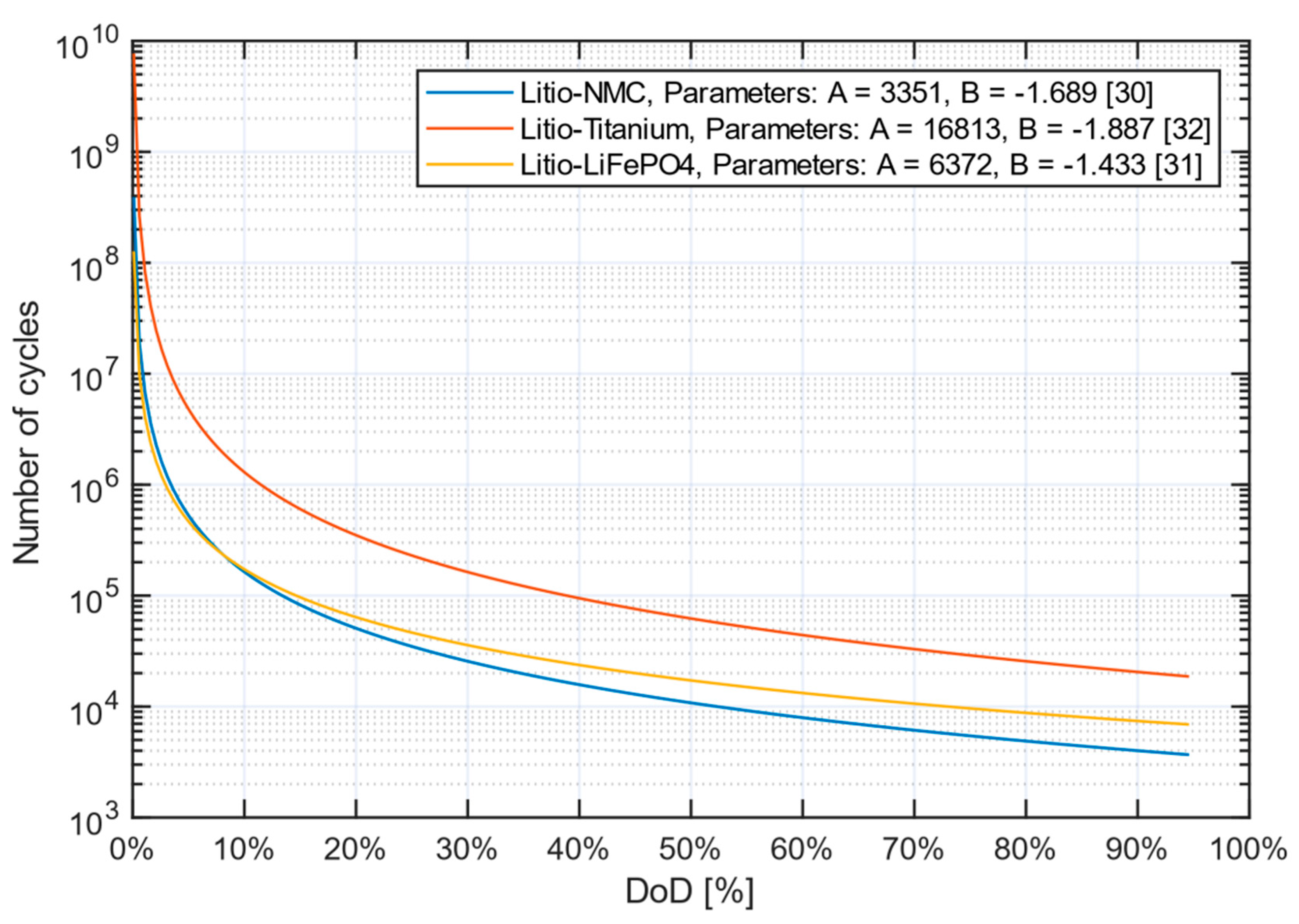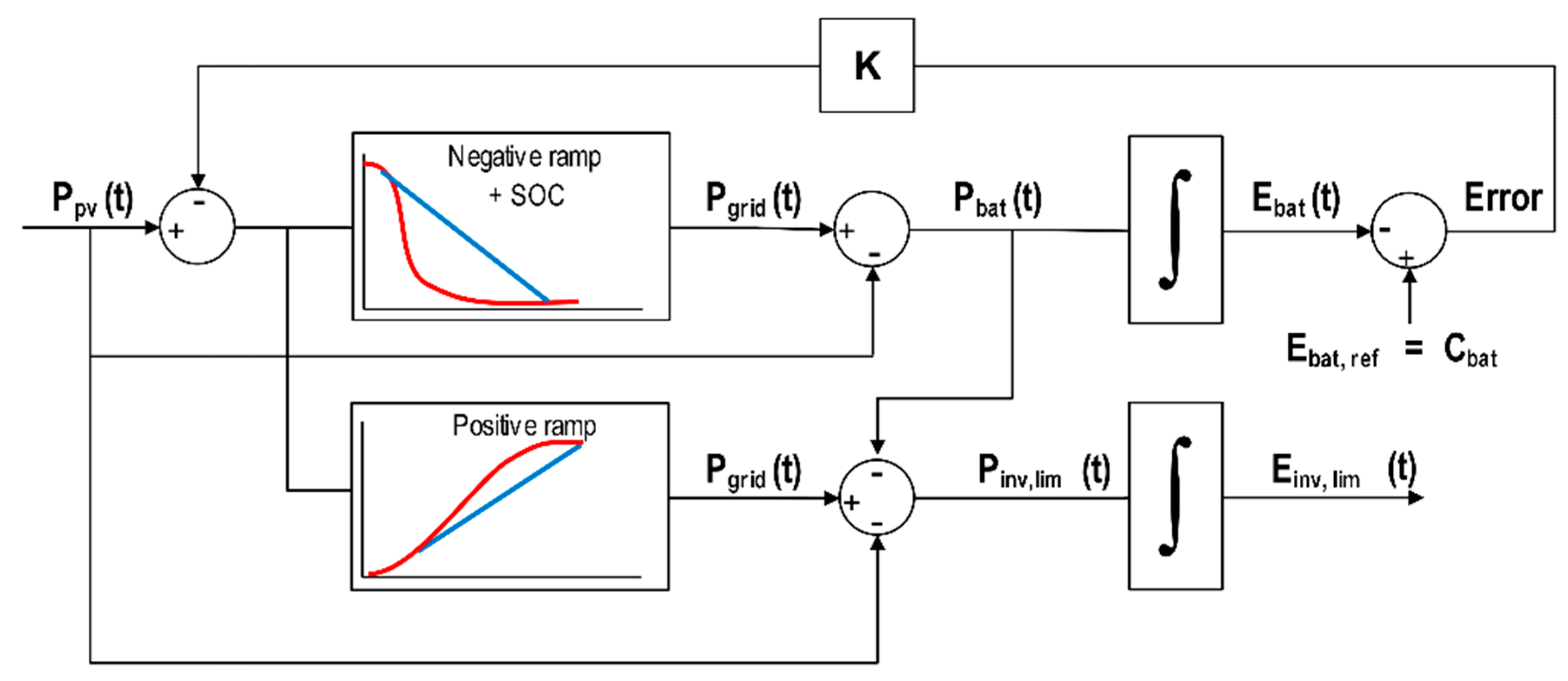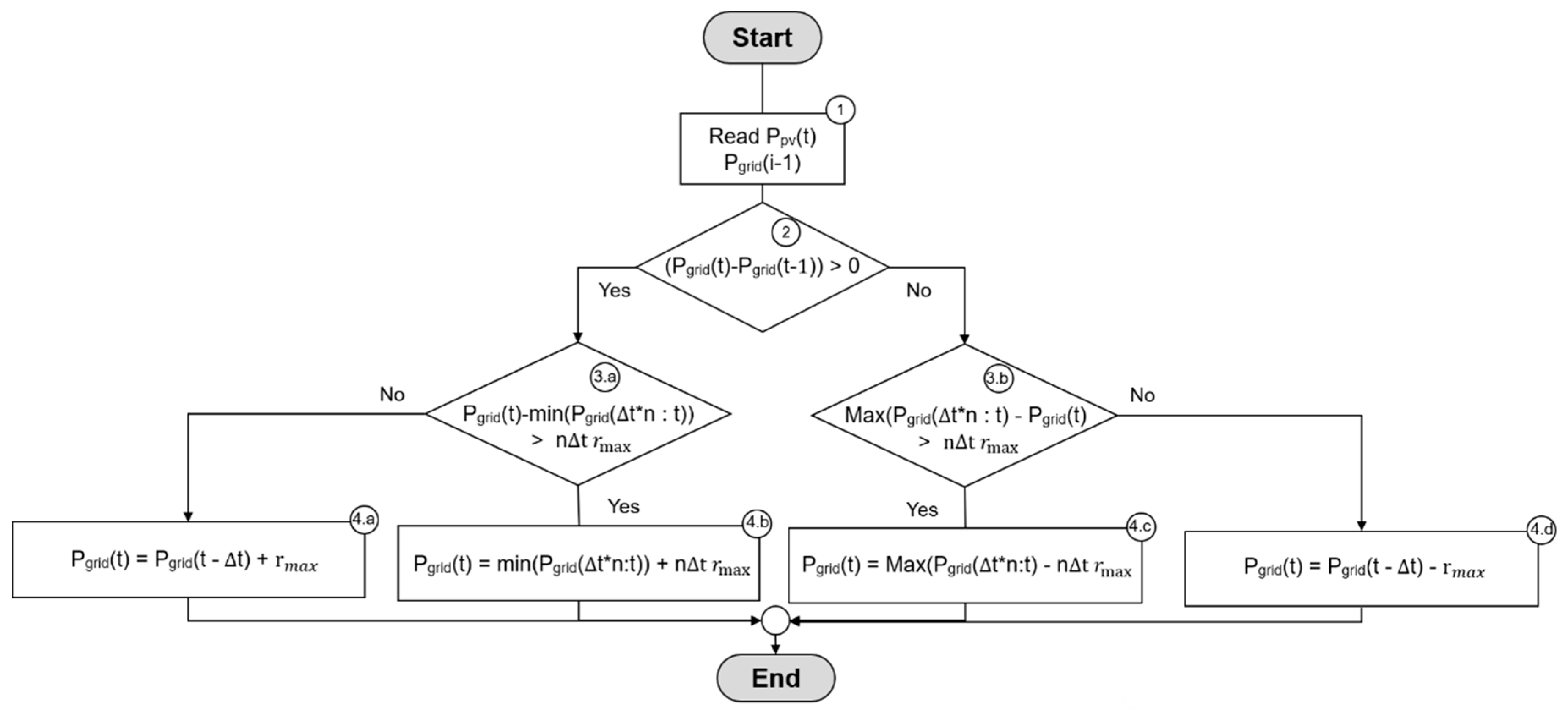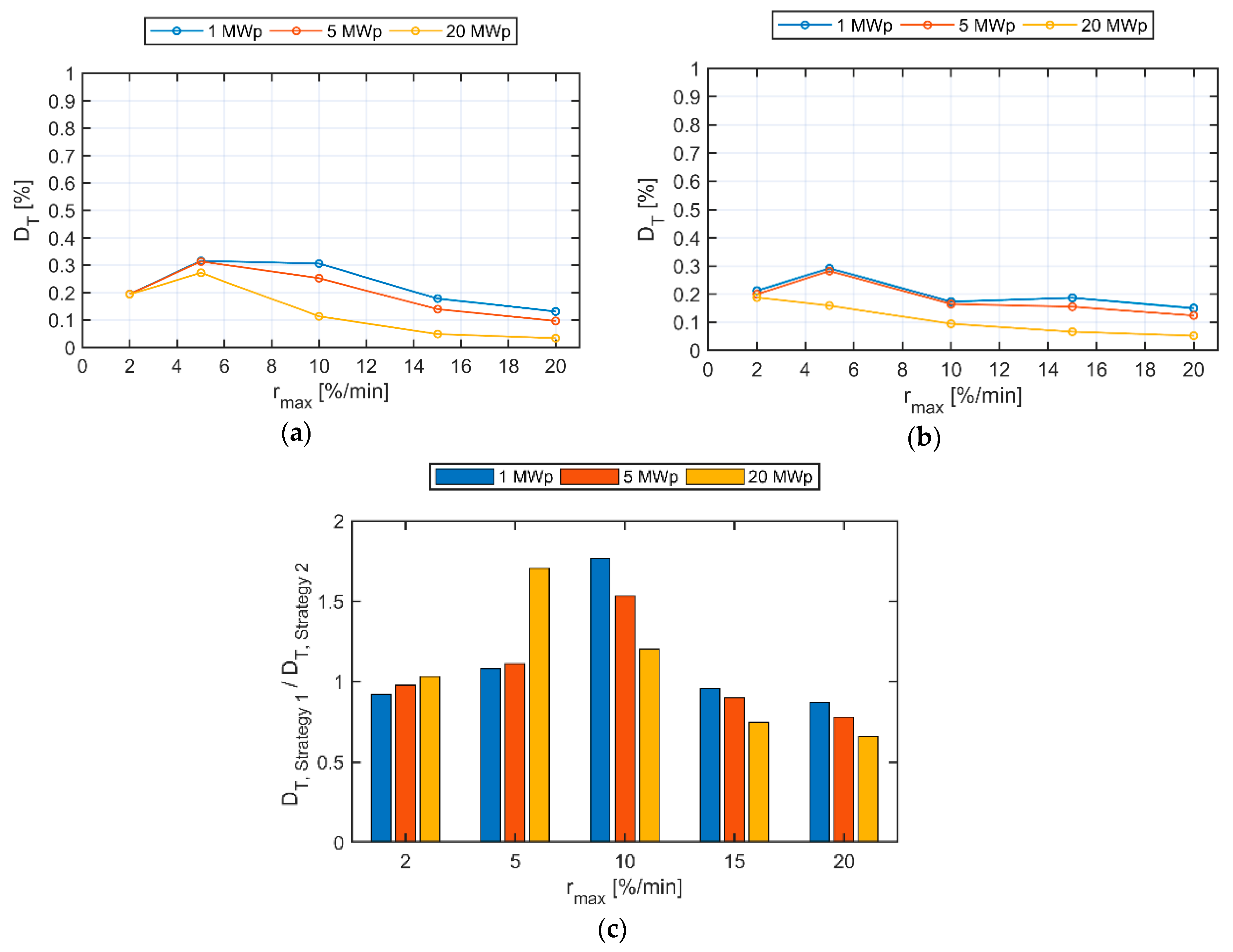Comparative Analysis of Degradation Assessment of Battery Energy Storage Systems in PV Smoothing Application
Abstract
:1. Introduction
2. Estimation of BESS Degradation
- (i)
- Physical-chemical aging model: based on a detailed knowledge of the processes related to the aging of batteries, describing them using partial differential equations and providing the most important state variables at any point in the cell and at any time.
- (ii)
- Semi-empirical model: assumes that the useful life of the batteries is proportional to the amount of charge transferred from them. The actual value of the transferred charge is multiplied by a weighted factor, calculated according to the conditions of use of the battery. This weighted factor can be linear or non-linear, depending on the stress element you are considering.
- (iii)
- Event-oriented aging model: considers only a cycle life stress factor, which is the depth of discharge combined with data generally provided by manufacturers, such as the number of cycles curve versus the depth of discharge.
2.1. Event-Oriented Modeling: Rainflow Counting and BESS Degradation Estimation
2.2. BESS Semiempirical Degradation Model
3. Control Strategies to Smoothing Output PV Power
3.1. Strategy 1: Inverter Power Limitation
3.2. Strategy 2: Step-Rate
4. Results
5. Conclusions
Author Contributions
Funding
Institutional Review Board Statement
Informed Consent Statement
Data Availability Statement
Acknowledgments
Conflicts of Interest
References
- Shivashankar, S.; Mekhilef, S.; Mokhlis, H.; Karimi, M. Mitigating Methods of Power Fluctuation of Photovoltaic (PV) Sources—A Review. Renew. Sustain. Energy Rev. 2016, 59, 1170–1184. [Google Scholar] [CrossRef]
- Marcos, J.; Storkël, O.; Marroyo, L.; Garcia, M.; Lorenzo, E. Storage Requirements for PV Power Ramp-Rate Control. Sol. Energy 2014, 99, 28–35. [Google Scholar] [CrossRef] [Green Version]
- Smart Energy Grid Engineering; Gabbar, H.A. (Ed.) Academic Press: London, UK; San Diego, CA, USA, 2017; ISBN 978-0-12-805343-0. [Google Scholar]
- Mansouri, N.; Lashab, A.; Sera, D.; Guerrero, J.M.; Cherif, A. Large Photovoltaic Power Plants Integration: A Review of Challenges and Solutions. Energies 2019, 12, 3798. [Google Scholar] [CrossRef] [Green Version]
- Gevorgian, V.; Booth, S. Review of PREPA Technical Requirements for Interconnecting Wind and Solar Generation; Energy Lab.(NREL): Golden, CO, USA, 2013. [Google Scholar]
- Comisión Reguladora de Energia. Reglas Generales de Interconexión al Sistema Eléctrico Nacional. 2012. Available online: https://www.cre.gob.mx/documento/2195.pdf (accessed on 5 October 2020).
- Energinet.dk. Technical Regulation 3.2.2 for PV Power Plants Above 11 KW; Energinet.dk: Copenhagen, Denamark, 2016; p. 108. [Google Scholar]
- Alam, M.J.E.; Saha, T.K. Cycle-Life Degradation Assessment of Battery Energy Storage Systems Caused by Solar PV Variability. In Proceedings of the 2016 IEEE Power and Energy Society General Meeting (PESGM), Boston, MA, USA, 17–21 July 2016; IEEE: Boston, MA, USA, 2016; pp. 1–5. [Google Scholar]
- Craciun, B.-I.; Kerekes, T.; Sera, D.; Teodorescu, R.; Annakkage, U.D. Power Ramp Limitation Capabilities of Large PV Power Plants With Active Power Reserves. IEEE Trans. Sustain. Energy 2017, 8, 573–581. [Google Scholar] [CrossRef]
- Zheng, Q.; Li, J.; Ai, X.; Wen, J.; Fang, J. Overivew of Grid Codes for Photovoltaic Integration. In Proceedings of the 2017 IEEE Conference on Energy Internet and Energy System Integration (EI2), Beijing, China, 26–28 November 2017; pp. 1–6. [Google Scholar]
- Alam, M.J.E.; Muttaqi, K.M.; Sutanto, D. A Novel Approach for Ramp-Rate Control of Solar PV Using Energy Storage to Mitigate Output Fluctuations Caused by Cloud Passing. IEEE Trans. Energy Convers. 2014, 29, 507–518. [Google Scholar] [CrossRef] [Green Version]
- De la Parra, I.; Marcos, J.; García, M.; Marroyo, L. Dealing with the Implementation of Ramp-Rate Control Strategies—Challenges and Solutions to Enable PV Plants with Energy Storage Systems to Operate Correctly. Sol. Energy 2018, 169, 242–248. [Google Scholar] [CrossRef]
- Kim, N.K.; Cha, H.J.; Seo, J.J.; Won, D.J. SOC Management Algorithm of Battery Energy Storage System for PV Ramp Rate Control. In Proceedings of the 2017 6th International Youth Conference on Energy (IYCE), Budapest, Hungary, 21–24 June 2017; IEEE: Budapest, Hungary, 2017; pp. 1–6. [Google Scholar]
- Marcos, J.; de la Parra, I.; García, M.; Marroyo, L. Control Strategies to Smooth Short-Term Power Fluctuations in Large Photovoltaic Plants Using Battery Storage Systems. Energies 2014, 7, 6593–6619. [Google Scholar] [CrossRef]
- Makibar, A.; Narvarte, L.; Lorenzo, E. On the Relation between Battery Size and PV Power Ramp Rate Limitation. Sol. Energy 2017, 142, 182–193. [Google Scholar] [CrossRef] [Green Version]
- Ellis, A.; Schoenwald, D.; Hawkins, J.; Willard, S.; Arellano, B. PV Output Smoothing with Energy Storage. In Proceedings of the 2012 38th IEEE Photovoltaic Specialists Conference, Austin, TX, USA, 3–8 June 2012; pp. 1523–1528. [Google Scholar]
- Sukumar, S.; Mokhlis, H.; Mekhilef, S.; Karimi, M.; Raza, S. Ramp-Rate Control Approach Based on Dynamic Smoothing Parameter to Mitigate Solar PV Output Fluctuations. Int. J. Electr. Power Energy Syst. 2018, 96, 296–305. [Google Scholar] [CrossRef]
- Van Haaren, R.; Morjaria, M.; Fthenakis, V. An Energy Storage Algorithm for Ramp Rate Control of Utility Scale PV (Photovoltaics) Plants. Energy 2015, 91, 894–902. [Google Scholar] [CrossRef]
- Martins, J.; Spataru, S.; Sera, D.; Stroe, D.-I.; Lashab, A. Comparative Study of Ramp-Rate Control Algorithms for PV with Energy Storage Systems. Energies 2019, 12, 1342. [Google Scholar] [CrossRef] [Green Version]
- Saez-de-Ibarra, A.; Martinez-Laserna, E.; Stroe, D.-I.; Swierczynski, M.; Rodriguez, P. Sizing Study of Second Life Li-Ion Batteries for Enhancing Renewable Energy Grid Integration. IEEE Trans. Ind. Appl. 2016, 52, 4999–5008. [Google Scholar] [CrossRef] [Green Version]
- PV Fluctuation Balancing Using Hydrogen Storage—A Smoothing Method for Integration of PV Generation into the Utility Grid—ScienceDirect. Available online: https://www.sciencedirect.com/science/article/pii/S187661021101959X (accessed on 7 June 2020).
- Beltran, H.; Bilbao, E.; Belenguer, E.; Etxeberria-Otadui, I.; Rodriguez, P. Evaluation of Storage Energy Requirements for Constant Production in PV Power Plants. IEEE Trans. Ind. Electron. 2013, 60, 1225–1234. [Google Scholar] [CrossRef]
- Marcos, J.; Marroyo, L.; Lorenzo, E.; Alvira, D.; Izco, E. From Irradiance to Output Power Fluctuations: The PV Plant as a Low Pass Filter. Prog. Photovolt. Res. Appl. 2011, 19, 505–510. [Google Scholar] [CrossRef] [Green Version]
- Chawla, M.; Naik, R.; Burra, R.; Wiegman, H. Utility Energy Storage Life Degradation Estimation Method. In Proceedings of the 2010 IEEE Conference on Innovative Technologies for an Efficient and Reliable Electricity Supply, Waltham, MA, USA, 27–29 September 2010; IEEE: Waltham, MA, USA, 2010; pp. 302–308. [Google Scholar]
- Karmiris, G.; Tengner, T. Control Method Evaluation for Battery Energy Storage System Utilized in Renewable Smoothing. In Proceedings of the IECON 2013—39th Annual Conference of the IEEE Industrial Electronics Society, Vienna, Austria, 10–13 November 2013; IEEE: Vienna, Austria, 2013; pp. 1566–1570. [Google Scholar]
- Alipour, M.; Ziebert, C.; Conte, F.V.; Kizilel, R. A Review on Temperature-Dependent Electrochemical Properties, Aging, and Performance of Lithium-Ion Cells. Batteries 2020, 6, 35. [Google Scholar] [CrossRef]
- Björklund, E.; Wikner, E.; Younesi, R.; Brandell, D.; Edström, K. Influence of State-of-Charge in Commercial LiNi0.33Mn0.33Co0.33O2/LiMn2O4-Graphite Cells Analyzed by Synchrotron-Based Photoelectron Spectroscopy. J. Energy Storage 2018, 15, 172–180. [Google Scholar] [CrossRef]
- Schmalstieg, J.; Käbitz, S.; Ecker, M.; Sauer, D.U. A Holistic Aging Model for Li(NiMnCo)O2 Based 18650 Lithium-Ion Batteries. J. Power Sources 2014, 257, 325–334. [Google Scholar] [CrossRef]
- Naumann, M.; Truong, C.N.; Schimpe, M.; Kucevic, D.; Jossen, A.; Hesse, H.C. SimSES: Software for Techno-Economic Simulation of Stationary Energy Storage Systems. In Proceedings of the International ETG Congress 2017, Berlin, Germany, 28–29 November 2017; pp. 1–6. [Google Scholar]
- ASTM International. Practices for Cycle Counting in Fatigue Analysis; ASTM International: West Conshohocken, PA, USA, 2017. [Google Scholar]
- Intensium Max+ 20P Datasheet; Saft, 2017. Available online: https://www.saftbatteries.com/products-solutions/products/intensium%C2%AE-max-megawatt-energy-storage-system (accessed on 17 December 2020).
- Xu, B.; Oudalov, A.; Ulbig, A.; Andersson, G.; Kirschen, D.S. Modeling of Lithium-Ion Battery Degradation for Cell Life Assessment. IEEE Trans. Smart Grid 2018, 9, 1131–1140. [Google Scholar] [CrossRef]
- Altairnano. PowerRack Technical Information. Available online: https://altairnano.com/products/powerrack/ (accessed on 10 December 2020).
- Wu, J.; Wei, Z.; Li, W.; Wang, Y.; Li, Y.; Sauer, D.U. Battery Thermal- and Health-Constrained Energy Management for Hybrid Electric Bus Based on Soft Actor-Critic DRL Algorithm. IEEE Trans. Ind. Inf. 2021, 17, 3751–3761. [Google Scholar] [CrossRef]
- Wei, Z.; Zhao, J.; He, H.; Ding, G.; Cui, H.; Liu, L. Future Smart Battery and Management: Advanced Sensing from External to Embedded Multi-Dimensional Measurement. J. Power Sources 2021, 489, 229462. [Google Scholar] [CrossRef]
- Rumpf, K.; Naumann, M.; Jossen, A. Experimental Investigation of Parametric Cell-to-Cell Variation and Correlation Based on 1100 Commercial Lithium-Ion Cells. J. Energy Storage 2017, 14, 224–243. [Google Scholar] [CrossRef]
- Schnabel, J.; Valkealahti, S. Energy Storage Requirements for PV Power Ramp Rate Control in Northern Europe. Int. J. Photoenergy 2016, 2016, 2863479. [Google Scholar] [CrossRef] [Green Version]
- Samsung SDI. Battery Brochure. 2019. Available online: https://www.samsungsdi.com/upload/ess_brochure/201902_Samsung%20SDI%20ESS_EN.pdf (accessed on 11 December 2020).
- Kokam. Cell Datasheet. 2019. Available online: https://kokam.com/data/filebox/cell_brochure.pdf (accessed on 12 December 2020).
- De la Parra, I.; Marcos, J.; García, M.; Marroyo, L. Control Strategies to Use the Minimum Energy Storage Requirement for PV Power Ramp-Rate Control. Sol. Energy 2015, 111, 332–343. [Google Scholar] [CrossRef]
- De la Parra, I.; Marcos, J.; García, M.; Marroyo, L. Improvement of a Control Strategy for PV Power Ramp-Rate Limitation Using the Inverters: Reduction of the Associated Energy Losses. Sol. Energy 2016, 127, 262–268. [Google Scholar] [CrossRef]











| Country | Positive Ramp | Negative Ramp | Ref. |
|---|---|---|---|
| Germany | 10 %/min | No | [9] |
| China <30 MW 30–150 MW >150 MW | 3 MW/min Installed capacity/10 15 MW/min | 3 MW/min Installed capacity/10 15 MW/min | [10] |
| Denmark | 100 kW/s | 100 kW/s | [7] |
| Ireland | 30 MW/min | No | [9] |
| México | 2–5%/min | 1–5%/min | [6] |
| Puerto Rico | 10%/min | 10%/min | [5] |
| State | Operation Mode | Pbat (t) | Sign | Pinv,lim (t) |
|---|---|---|---|---|
| 1 | Standby | 0 | 0 | |
| 2 | Ramp-Down | 0 > D | 0 | |
| 3 | SoC Recovery/No ramp | 0 < C | 0 | |
| 4 | SoC recovery/Ramp-Up | 0 < C | 0 | |
| 5 | Limited ramp-up | 0 | 1 |
| rmax [%/min] | Event-Oriented Model [%] | SimSES Model [%] | Relative Difference [%] | |||
|---|---|---|---|---|---|---|
| DT, Strategy1 | DT, Strategy2 | DT, Strategy1 | DT, Strategy2 | DT, Strategy1 | DT, Strategy2 | |
| 2 | 0.2 | 0.2 | 0.5 | 0.4 | 150 | 50 |
| 10 | 0.3 | 0.2 | 0.6 | 0.4 | 100 | 50 |
| 20 | 0.1 | 0.1 | 0.4 | 0.2 | 300 | 100 |
| rmax [%/min] | DT, Strategy1 Ebat, ref = 80% SOC | DT, Strategy1 Ebat, ref = 100% SOC | Difference [%] |
|---|---|---|---|
| 2 | 0,3 | 0,5 | −40 |
| 10 | 0,4 | 0,6 | −33 |
| 20 | 0,2 | 0,4 | −50 |
Publisher’s Note: MDPI stays neutral with regard to jurisdictional claims in published maps and institutional affiliations. |
© 2021 by the authors. Licensee MDPI, Basel, Switzerland. This article is an open access article distributed under the terms and conditions of the Creative Commons Attribution (CC BY) license (https://creativecommons.org/licenses/by/4.0/).
Share and Cite
Diaz, V.S.; Cantane, D.A.; Santos, A.Q.O.; Ando Junior, O.H. Comparative Analysis of Degradation Assessment of Battery Energy Storage Systems in PV Smoothing Application. Energies 2021, 14, 3600. https://doi.org/10.3390/en14123600
Diaz VS, Cantane DA, Santos AQO, Ando Junior OH. Comparative Analysis of Degradation Assessment of Battery Energy Storage Systems in PV Smoothing Application. Energies. 2021; 14(12):3600. https://doi.org/10.3390/en14123600
Chicago/Turabian StyleDiaz, Valentin Silvera, Daniel Augusto Cantane, André Quites Ordovás Santos, and Oswaldo Hideo Ando Junior. 2021. "Comparative Analysis of Degradation Assessment of Battery Energy Storage Systems in PV Smoothing Application" Energies 14, no. 12: 3600. https://doi.org/10.3390/en14123600







